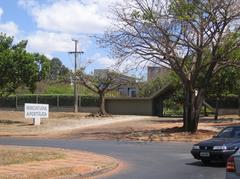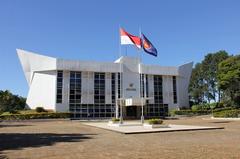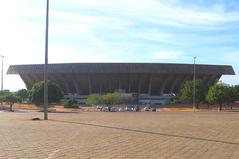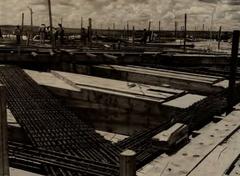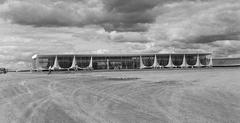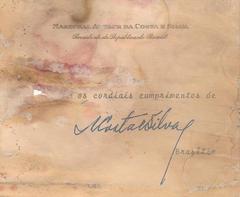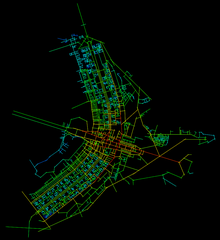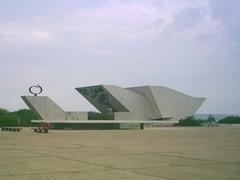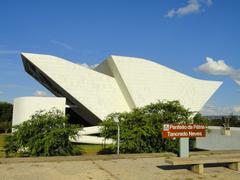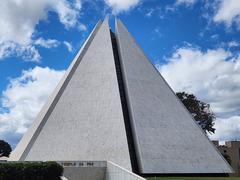Visiting Hours, Tickets, and Guide to Esplanada dos Ministérios, Brasília
Date: 31/07/2024
Introduction
The Esplanada dos Ministérios, or Ministries Esplanade, is a testament to Brazil’s mid-20th-century aspirations and a symbol of its administrative and political heart. Located in Brasília, the capital city, this grand avenue is flanked by 17 identical ministry buildings that represent the nation’s federal ministries. The Esplanada dos Ministérios is a marvel of modernist architecture and urban planning, designed by Lúcio Costa and Oscar Niemeyer, two of the most influential figures in modernist architecture (ArchDaily). The vision to create a new capital city in the interior of Brazil was first mentioned in the 1889 Brazilian constitution, but it wasn’t until 1956, under President Juscelino Kubitschek, that this vision became a reality. Kubitschek’s ambitious plan was to promote the development of Brazil’s interior and reduce the concentration of political and economic power in coastal cities like Rio de Janeiro (The Conversation).
The construction of Brasília, including the Esplanada dos Ministérios, was a monumental task completed in a remarkably short period, with the city officially inaugurated on April 21, 1960 (Wikipedia). The Esplanada dos Ministérios is not only an architectural gem but also a hub of cultural and political activity. It hosts numerous public events, celebrations, and gatherings, making it a vibrant public space. The esplanade’s design reflects modernist ideals of efficiency, transparency, and progress, which were central to the vision of Brasília as a new capital for a new era (The Conversation). Whether you’re a history enthusiast, an architecture lover, or simply a curious traveler, this guide will provide you with all the essential information you need to make the most of your visit to the Esplanada dos Ministérios.
Table of Contents
- [History and Significance of Esplanada dos Ministérios](#history-and-significance-of-esplanada-dos-ministérioshistory-and-significance-of-esplanada-dos-ministérios)
- [The Vision and Planning](#the-vision-and-planningthe-vision-and-planning)
- [Architectural and Urban Design](#architectural-and-urban-designarchitectural-and-urban-design)
- [Construction and Inauguration](#construction-and-inaugurationconstruction-and-inauguration)
- [Architectural Significance](#architectural-significancearchitectural-significance)
- [Cultural and Political Significance](#cultural-and-political-significancecultural-and-political-significance)
- [Events and Public Gatherings](#events-and-public-gatheringsevents-and-public-gatherings)
- [Iconic Structures](#iconic-structuresiconic-structures)
- [UNESCO World Heritage Status](#unesco-world-heritage-statusunesco-world-heritage-status)
- [Modern-Day Relevance](#modern-day-relevancemodern-day-relevance)
- [Visitor Information](#visitor-informationvisitor-information)
- [Visiting Hours and Tickets](#visiting-hours-and-ticketsvisiting-hours-and-tickets)
- [Travel Tips](#travel-tipstravel-tips)
- [Nearby Attractions](#nearby-attractionsnearby-attractions)
- [Guided Tours and Special Events](#guided-tours-and-special-eventsguided-tours-and-special-events)
- [Photographic Spots](#photographic-spotsphotographic-spots)
- [Accessibility](#accessibilityaccessibility)
- [FAQ](#faqfaq)
- [Conclusion](#conclusionconclusion)
- [Call to Action](#call-to-actioncall-to-action)
History and Significance of Esplanada dos Ministérios
The Vision and Planning
The concept of Brasília as a new capital dates back to 1889, when the Brazilian constitution first mentioned the idea of relocating the capital to the interior of the country. However, it wasn’t until 1956, under the presidency of Juscelino Kubitschek, that this vision began to materialize. Kubitschek’s ambitious plan aimed to promote the development of the interior and reduce the concentration of political and economic power in the coastal cities, particularly Rio de Janeiro (The Conversation).
Architectural and Urban Design
The urban planning of Brasília was entrusted to Lúcio Costa, while the architectural design of the major buildings, including those on the Esplanada dos Ministérios, was the work of Oscar Niemeyer. Costa’s plan for Brasília, known as the Plano Piloto, featured a cross-shaped layout with the Monumental Axis (Eixo Monumental) forming the main thoroughfare. The Esplanada dos Ministérios is a significant part of this axis, designed as a grand avenue flanked by the identical ministry buildings (ArchDaily).
Construction and Inauguration
Construction of Brasília began in 1956 and was completed in a remarkably short period, with the city officially inaugurated on April 21, 1960. The rapid construction was driven by Kubitschek’s determination to see the project completed within his presidential term. The Esplanada dos Ministérios, with its 17 identical ministry buildings, was a central element of this new capital, symbolizing the administrative heart of the nation (Wikipedia).
Architectural Significance
The buildings along the Esplanada dos Ministérios were designed by Oscar Niemeyer, a leading figure in modernist architecture. Niemeyer’s designs are characterized by their bold, futuristic forms and innovative use of concrete. The ministry buildings are notable for their uniformity and simplicity, which create a sense of order and harmony along the esplanade. The structural engineering for these buildings was provided by Joaquim Cardozo, ensuring their stability and durability (ArchDaily).
Cultural and Political Significance
The Esplanada dos Ministérios is not only an architectural marvel but also a symbol of Brazil’s political and administrative power. It houses the headquarters of various federal ministries, making it the epicenter of the country’s governmental operations. The esplanade’s design reflects the modernist ideals of efficiency, transparency, and progress, which were central to the vision of Brasília as a new capital for a new era (The Conversation).
Events and Public Gatherings
The expansive grassy area of the Esplanada dos Ministérios serves as a venue for numerous public events and celebrations. It is the site of Brasília’s annual New Year’s Eve festivities, carnival events, and the city’s anniversary celebrations. The esplanade has also hosted significant cultural and musical events, such as the recording of the gospel album “Nos Braços do Pai” by Diante do Trono, which drew an audience of approximately 1.2 million people in 2002, and a concert by the Mexican pop group RBD in 2008, attended by over 500,000 people (Wikipedia).
Iconic Structures
Several iconic structures are located along the Esplanada dos Ministérios, adding to its significance. The Metropolitan Cathedral of Brasília, designed by Niemeyer and opened in 1970, is a striking example of modernist architecture. Its hyperboloid structure and suspended angels create a surreal and ethereal atmosphere, making it a must-visit for tourists and architecture enthusiasts alike (Strange Buildings).
UNESCO World Heritage Status
In recognition of its unique urban planning and architectural significance, Brasília, including the Esplanada dos Ministérios, was designated a UNESCO World Heritage Site in 1987. This status underscores the city’s importance as a model of modernist urbanism and its influence on urban planning worldwide. The preservation of the Plano Piloto and its key elements, such as the Esplanada dos Ministérios, ensures that future generations can appreciate this landmark of 20th-century architecture and urban design (The Conversation).
Modern-Day Relevance
Today, the Esplanada dos Ministérios continues to function as the administrative heart of Brazil, housing the offices of various federal ministries. It remains a focal point for political activities, public demonstrations, and national celebrations. The esplanade’s design and layout, with its wide open spaces and uniform buildings, continue to reflect the modernist ideals of order, efficiency, and progress that inspired its creation (Wikipedia).
Visitor Information
Visiting Hours and Tickets
The Esplanada dos Ministérios is accessible to the public 24/7. However, access to individual ministry buildings may be restricted and typically operates during standard business hours (Monday to Friday, 9 AM to 6 PM). There is no admission fee to walk along the esplanade, but guided tours may have associated costs. It’s recommended to check the official websites of the specific ministries or tour operators for the most up-to-date information.
Travel Tips
- Best Time to Visit: The best time to visit is during the dry season (May to September) when the weather is more comfortable for walking tours.
- Getting There: Brasília is well-connected by air and road. Once in the city, you can reach the Esplanada dos Ministérios by taxi, bus, or bike. There are also parking facilities nearby.
- What to Bring: Comfortable walking shoes, water, sunscreen, and a hat are recommended, especially if you plan to explore on foot. Don’t forget your camera to capture the stunning architecture.
Nearby Attractions
- Praça dos Três Poderes (Three Powers Plaza): Located at the end of the esplanade, this plaza is home to the Presidential Palace, the National Congress, and the Supreme Federal Court.
- Juscelino Kubitschek Memorial: A museum dedicated to the president who founded Brasília, offering insights into his life and the city’s history.
- Parque da Cidade (City Park): A large urban park ideal for picnics, jogging, and family outings.
Guided Tours and Special Events
Several tour operators offer guided tours of the Esplanada dos Ministérios, providing detailed insights into its history and architecture. Check online reviews and book in advance to secure your spot. The esplanade also hosts various special events throughout the year, so keep an eye on local event calendars for unique experiences.
Photographic Spots
The Esplanada dos Ministérios offers numerous photographic opportunities. Some popular spots include the Metropolitan Cathedral, the National Congress building, and the wide-open spaces along the esplanade itself. Sunrise and sunset are particularly magical times for photography.
Accessibility
The esplanade is wheelchair accessible, with ramps and smooth pathways. Public restrooms and other facilities are also designed to accommodate visitors with disabilities. For specific accessibility needs, it’s best to contact the individual ministry buildings or tour operators in advance.
FAQ
Q: What are the visiting hours for the Esplanada dos Ministérios? A: The esplanade is open to the public 24/7, but access to ministry buildings is typically during business hours (Monday to Friday, 9 AM to 6 PM).
Q: Is there an admission fee? A: There is no fee to walk along the esplanade, but guided tours may have associated costs.
Q: What is the best time to visit? A: The dry season (May to September) is the best time for comfortable walking tours.
Q: Are there guided tours available? A: Yes, several tour operators offer guided tours. It’s advisable to book in advance.
Q: Are there any nearby attractions? A: Yes, nearby attractions include Praça dos Três Poderes, Juscelino Kubitschek Memorial, and Parque da Cidade.
Conclusion
The Esplanada dos Ministérios stands as a testament to Brazil’s mid-20th-century aspirations and remains a symbol of its political and administrative power. Whether you’re interested in its history, architecture, or simply want to enjoy a grand public space, this landmark offers a rich and rewarding experience for all visitors. Plan your visit today and explore the heart of Brazil’s capital.
Call to Action
For more travel tips and updates on Brasília’s attractions, download our mobile app Audiala, check out our other related posts, and follow us on social media.
